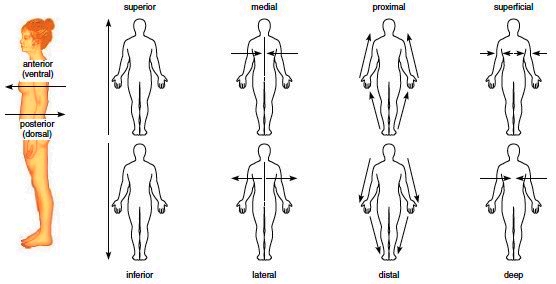The regional terms are used to designate the specific area from the major body divisions as illustrated in figure below.
Figure 1.4 Regional terms used for designate specific body areas
|
Anterior
|
Posterior
|
||||
|
Term
|
Meaning
|
Term
|
Meaning
|
Term
|
Meaning
|
|
Frontal
|
Forehead
|
Buccal
|
Cheek
|
Dorsum of foot
|
Back of foot
|
|
Facial
|
Face
|
Mental
|
Chin
|
Occipital
|
Back of head
|
|
Cervical
|
Neck
|
Antecubital
|
Elbow front
|
Scapular
|
Shoulder blade
|
|
Pectoral
|
Chest
|
Pelvic
|
Pelvis
|
Vertebral
|
Spinal
|
|
Acromial
|
Shoulder point
|
Pollex
|
Thumb
|
Lumbar
|
Lower back
|
|
Brachial
|
Arm
|
Digital
|
Fingers/ toe
|
Sacral
|
Between hip
|
|
Thoracic
|
Chest
|
Mammary
|
Breast
|
Gluteal
|
Buttock
|
|
Cubital
|
Elbow
|
Fibular
|
Side of leg
|
Dorsum of hand
|
Back of hand
|
|
Sternal
|
Breastbone
|
Hallux
|
Great toe
|
Perineal
|
Between anus and genitalia
|
|
Abdominal
|
Abdomen
|
Pedal
|
Foot
|
Popliteal
|
Posterior knee
|
|
Umbilical
|
Navel
|
Tarsal
|
Ankle
|
Calcaneal
|
Heel
|
|
Antebrachial
|
Forearm
|
Pubic
|
Genital
|
Cephalic
|
Head
|
|
Inguinal
|
Groin
|
Femoral
|
Thigh
|
Otic
|
Ear
|
|
Coxal
|
Hip
|
Patellar
|
Anterior knee
|
Dorsal
|
Back
|
|
Carpal
|
Wrist
|
Crural
|
Leg
|
Olecranal
|
Back of elbow
|
|
Palmar
|
Palm
|
Nasal
|
Nose
|
Sural
|
Calf
|
|
Axillary
|
Armpit
|
Orbital
|
Eye
|
Plantar
|
Sole`
|
Table 1.2 Regional terms and meanings.
Body Cavities
Cavity is the hollow space or body compartment. The body cavity is divided by two parts which are dorsal cavity and ventral cavity. Dorsal cavity contain cranial cavity and spinal cavity while ventral cavity contain abdominal cavity and pelvic cavity.
 |
| Figure 1.5 The body cavities |
- Cranial cavity - space in the head that contains brain with cranial bones.
- Vertebral cavity - space containing spinal cords and also the beginning of spinal nerves.
- Thoracic cavity - space that contains pleural and pericardial cavities and mediastinum.
- Pleural cavity - spaces which each of them surrounds a lung.
- Pericardial cavity - spaces that surrounds the heart.
- Mediastinum - central portion of thoracic cavity between the lungs containing heart, thymus, oesophagus, trachea, and blood vessels.
- Abdominopelvic cavity - body compartment that has two cavities as single unit ; abdominal cavity and pelvic cavity.
- Abdominal cavity - hollow space that contains major digestive organs.
- Pelvic cavity - space formed by hip bones & contains reproductive and excretory systems.
Regions and Quadrants of The Abdominopelvic Cavity
These two standards of terminology universally used by doctors to describe the middle portion of the body (abdominal and pelvic cavities). Figure 1.6 illustrates the abdominopelvic regions and quadrants.
| Figure 1.6 The abdominopelvic region and abdominopelvic quadrants. |
- Hypochondriac region - area of the left and right sides of the body in the part of below of ribs.
- Epigastric region - area of the body immediately above the stomach.
- Lumbar region - area of the left and right sides of the body in part of back between ribs and pelvis.
- Umbilical region - area that surrounds the navel.
- Iliac region - left and right area of the body that located over the hip bones.
- Hypogastric region - area below the stomach.

